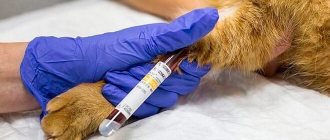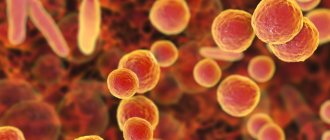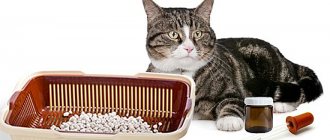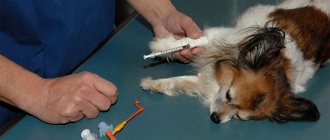The animal is nervous before visiting the veterinarian, what to do?
The situation is stressful, many animals begin to become very afraid just at the sight of a veterinary clinic. There is still no way to remove stress. Here you need to look at the condition of the animal, someone needs to get comfortable, sit in the waiting room for 10-15 minutes, some animals need to be taken “hot” until they come to their senses what is happening, someone likes to sit on your hands, etc. You need to look at your animal and choose the most suitable option in order to perform the manipulations.
And the main factor is the calmness of the owner, this is almost the most important thing that affects the animal. There is no need to overdramatize the situation and stress yourself, the animal and those around you.
The animal must understand that everything that is happening now is normal.
Under no circumstances should you use any sedatives, especially before taking tests.
What is prohibited before donating blood in dogs and cats
Blood is donated before the start of any treatment and 10-14 days after it is discontinued.
We exclude stress, travel, intense training, walks, fights, games. And any physical activity.
You cannot donate blood after X-rays or physical procedures.
It is necessary to exclude physical activities (running, climbing stairs and emotional excitement) immediately before donating blood. Therefore, the animal needs to be kept calm for some time, in the waiting room or on the street near the clinic, in the car.
Clinical blood test in dogs and cats transcript
Shows the state of health of the body as a whole based on the cellular composition of the blood.
Indicators
WBC - white blood cells - white blood cells - Leukocytes. Leukocytes. White blood cells, which are responsible for the body's immune response and for its protection against all kinds of pathological agents. Different types of leukocytes make up the leukocyte formula - the ratio of different types of leukocytes to their total number as a percentage.
Neutrophils, Eosinophils, Basophils, monocytes, lymphocytes.
- Neutrophils - responsible for destroying bacterial infections in the blood;
- Lymphocytes are a general indicator of immunity;
- Monocytes - are engaged in the destruction of foreign substances that enter the blood and threaten health;
- Eosinophils – fight allergens;
- Basophils - help recognize and identify foreign particles in the blood.
Absolute indicators reflect how many population cells are contained in a unit volume of blood plasma
- Lumph# lymphocytes
- Mon# monocytes
- Gran# Granulocytes (mainly neutrophils, eosinophils, basophils in a small number. Usually all the properties of Gran are determined by neutrophils
Indicators as a percentage of the total number of leukocytes
- Lumph%
- Mon%
- Gran%
Myelocytes are considered a type of leukocyte, but they are a somewhat separate indicator, because are located in the bone marrow and should not normally be detected in the blood.
RBC - (red blood cells - red blood cells ) - absolute content of red blood cells. Red blood cells containing heme protein (hemoglobin) and representing the bulk of the cellular mass of blood. One of the most informative indicators.
HGB - (Hb, hemoglobin) - concentration of hemoglobin, a complex blood protein, the main function of which is the transport of oxygen and carbon dioxide molecules between the cells of the body. Regulates acid-base levels.
HCT Hematocrit - Shows the total volume of all blood cells in the blood mass (simply density). Usually only red blood cells are taken into account. An indicator of the ability of blood to carry oxygen to cells and tissues.
MCV Average Red Blood Cell Volume —Displays the number and size of red blood cells.
MCH Average level of HGB (hemoglobin) in a red blood cell The average concentration and content of hemoglobin in red blood cells indicate how densely the red blood cells are saturated with hemoglobin. Based on these indicators, the type of anemia is determined.
MCHC Average concentration of red blood cells in hemoglobin (%) - shows not the amount of hemoglobin in the red blood cell , but the density with which the red blood pigment filled the cell.
ESR (ESR) is the erythrocyte sedimentation rate. It shows the presence of a pathological process in the body; it always deviates during illness and during the recovery period
RDW Red blood cell volume distribution is a measure of the range of variation of red blood cells (RBCs) in their size.
PLT Platelets These cells are responsible for the process of hemostasis (stopping blood during bleeding). Blood clotting, vascular integrity.
MPV Average platelet volume is an indicator characterizing the size of blood platelets circulating in the blood at the moment.
PDW Platelet volume distribution width
PCT - or thrombocrit, is the proportion of platelets in the total volume of whole blood
Dangerous deviations in indicators in a cat
Deviations from the norm (increased or decreased) indicate that a malfunction has occurred in the body. Monitoring allows you to timely identify the development of the disease and begin treatment.
Bilirubin
Bilirubin is part of bile.
Bilirubin colors the blood, so an increased amount of it leads to discoloration of the skin (jaundice).
An overestimated value indicates the development of liver diseases (hepatosis, hepatitis), as well as blockage of the bile ducts.
Scheme of bilirubin formation in the blood
A decrease in bilirubin levels is observed with anemia and bone marrow lesions.
Total protein
An increase is observed with dehydration due to vomiting and diarrhea. A decrease in protein levels is typical for intestinal diseases, chronic liver diseases (cirrhosis or hepatitis), renal failure, and fasting.
Proteins are involved in all metabolic processes in the body.
Protein synthesis
Creatinine
An increase in blood creatinine levels may indicate the development of hyperthyroidism or kidney failure. A decrease in this value is observed during protein starvation.
Elevated levels of creatinine in both urine and blood indicate that the cat's diet contains a lot of animal protein.
Urea
An increase in urea indicates impaired kidney function and blockage of the urinary tract. Also, an excess of this value is observed when feeding your pet food rich in animal protein.
Uric acid crystals under a microscope
A decrease in urea indicates intestinal dysfunction, liver pathologies or protein deficiency in the diet.
Glucose
The reasons for increased blood glucose are as follows:
- Cushing's syndrome;
- diabetes;
- release of adrenaline into the blood due to increased physical activity or severe stress;
- chronic kidney or liver diseases;
- pancreatitis;
- pancreatic tumors.
A decrease in value is observed with an overdose of insulin, prolonged fasting, poisoning with poisons or alcohol.
Blood glucose
Low glucose levels are also characteristic of pancreatic diseases.
Amylase
An increase in the rate is observed in the following diseases: pancreatitis, diabetes mellitus, peritonitis, volvulus, renal failure.
Also, a high level of amylase indicates intoxication of the body due to poisoning.
Amylase
A decrease in the indicator may be the result of taking anticoagulants, poisoning, or necrosis of pancreatic tissue. The analysis determines total amylase and pancreatic amylase. The norm is 500-1200 units/l.
Cholesterol
An increase in cholesterol levels is typical for pancreatitis, diabetes mellitus, hypothyroidism and kidney disease.
Deficiency is observed with the development of malignant neoplasms, impaired absorption of nutrients in the intestines, and unbalanced nutrition.
Cholesterol in the blood
AST and ALT
An increase in these indicators indicates the destruction of liver cells, which was caused by cirrhosis, hepatitis or other diseases. Also, an increase in AST and ALT can be a consequence of injury or heart failure.
A simultaneous decrease in AST and an increase in ALT indicates the development of infectious hepatitis.
Alkaline phosphatase
Increased alkaline phosphatase can occur in pregnant animals and in pets that eat fatty foods.
A high rate is also typical for bacterial infections of the intestines and stomach, and liver diseases.
A decrease in the level of alkaline phosphatase is observed with anemia, vitamin C deficiency, and long-term use of corticosteroids.
Alkaline phosphatase is a whole complex of enzymes that is found almost throughout the body in small quantities.
Phosphorus
An increase in phosphorus is characteristic of leukemia and bone tumors. Also, a high value is observed in renal failure, hypervitaminosis of vitamin D, and disorders of the endocrine system.
Phosphorus deficiency can result from a lack of growth hormone and vitamin D.
Long-term diarrhea also leads to a decrease in the indicator.
Calcium
An increase in calcium is typical for:
- dehydration;
- destruction of bone tissue due to cancer;
- excess vitamin D.
Calcium deficiency is observed with pancreatitis, lack of vitamin D, taking anticonvulsants, and chronic renal failure.
Biochemical blood test in dogs and cats
Helps to identify hidden pathological processes in the animal’s body. The analysis will show which organs are working poorly.
- Total protein, G/l of blood reflects the correctness of amino acid (protein) metabolism in the body.
- Total bilirubin, µmol/l. bile component, consisting of two forms - indirect and direct. Indirect is formed from erythrocyte breakdown, and bound (direct) is converted in the liver from indirect. Directly shows the functioning of the hepatobiliary system (biliary and hepatic). Refers to “color” indicators, because when it is exceeded in the body, the tissues turn yellow (a sign of jaundice)
- AST, IU\l aspartate aminotransferase - diagnosis of damage to the liver, heart (more points to the heart)
- ALT, IU\l Alanine aminotransferase - diagnosis of damage to the liver, heart (more points to the liver)
- Alkaline phosphatase, IU\l - control of liver function
- Amylase, IU\l pancreas
- Urea, mmol\l. the result of protein processing, which is excreted by the kidneys.
- Creatinine mmol\l. a muscle byproduct excreted from the body by the renal system.
- Cholesterol mmol\l. one of the structural cellular components, ensuring their strength, and also participates in the synthesis of many vital hormones. It can also be used to judge the nature of lipid metabolism.
- Albuimn, g/l, is the main blood protein produced by the liver.
- GGT (gamma-glutamyltransferase) units/l - in combination with other liver enzymes gives an idea of the functioning of the hepatobiliary system, pancreas and thyroid glands.
- Creatine phosphokinase is an enzyme that is found in large quantities in the skeletal muscle group. By its presence in the blood one can judge the work of the heart muscle,
- Glucose mmol\l.
- Electrolytes (potassium, total calcium, phosphorus, sodium, magnesium, chlorine) are responsible for membrane electrical properties. Thanks to the electrical potential difference, cells pick up and execute commands from the brain.
This is interesting:
- Ceftriaxone for cats and dogs, dosage, how to dilute Ceftriaxone is a third-generation drug from the “Cephalosporins” group of antibiotics. Ceftriaxone is inexpensive, effective and quite…
- Calcivirus in cats, treatment, symptoms, prognosis Feline calcivirus is a dangerous virus that affects all cats, regardless of breed and…
- Panleukopenia in cats, treatment regimen, symptoms, prognosis Panleukopenia, also called “feline distemper,” is a dangerous viral disease that affects the gastrointestinal tract,…
The procedure for taking blood for analysis
Blood is taken from the vein of the animal. To do this, the cat is placed on its side, and if the cat resists, it is secured in a special veterinary bag. Blood is taken from the front paw by shaving off a small area of fur. The injection site is treated with a disinfectant solution, a needle from a disposable syringe is inserted into the vein, blood in the amount of 2 ml is drawn into a test tube with heparin or sodium citrate.
What blood tests are performed in veterinary clinics?
In modern veterinary clinics, two laboratory blood tests are performed:
- General or clinical.
- Biochemical.
General blood test for a cat
A general blood test based on the number and condition of formed blood elements shows the health status of the cat’s body. When performing a general blood test, parasites such as dirofilaria (dirofilariasis), hemobartenella can be detected in a cat’s blood.
What indicators does the clinic’s veterinary specialist receive when conducting a general blood test:
- Hematocrit
- Hemoglobin.
- Average content and concentration of hemoglobin in an erythrocyte.
- Color indicator.
- ESR (erythrocyte sedimentation rate).
- Red blood cells.
- Leukocytes.
- Neutrophils.
- Lymphocytes.
- Eosinophils.
- Monocytes.
- Platelets.
- Basophils.
- Myelocytes.
Biochemical blood test for a cat
Biochemical blood tests allow veterinary specialists to identify subclinical (hidden) cat diseases. A biochemical blood test allows you to determine the functioning of the body’s enzymatic system and provide information about damage to a particular organ in a cat.
A biochemical blood test for a cat includes enzymatic, electrolyte, fat and substrate indicators.
Basic biochemical parameters:
- Glucose.
- Protein and albumin.
- Cholesterol.
- Bilirubin is direct and total.
- Alanine aminotransferase (ALT).
- Aspartate aminotransferase (AST).
- Lactate dehydrogenase.
- Gamma glutamyl transferase.
- Alkaline phosphatase.
- a –Amylase.
- Urea.
- Creatinine.
- Calcium.
- Magnesium.
- Creatine phosphokinase.
- Triglycerides.
- Phosphorus, inorganic.
- Electrolytes (potassium, calcium, sodium, iron, chlorine, phosphorus).











